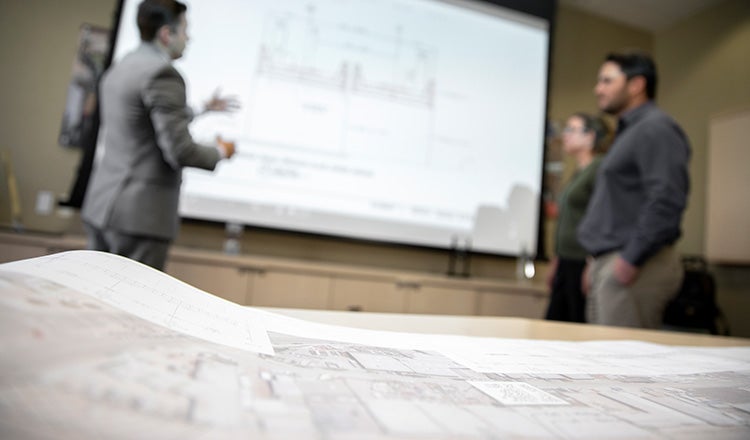
Experts Talk: Planning and Environmental Linkages with Gina McAfee and Jason Longsdorf
Experts Talk is an interview series with technical leaders from across our transportation program.
PEL Studies Offer Flexibility, Shorter Project Delivery for Transportation Improvements


Planning and environment linkage studies are becoming increasingly popular with state and local transportation agencies. These studies are similar to feasibility studies in that they provide a streamlined and flexible process to help decision-makers engage stakeholders, identify critical environmental resources and issues, and analyze potential transportation solutions. But their primary benefit is to remove duplication between planning studies and future environmental review processes. In so doing, they shorten the overall project delivery process, bringing transportation projects to construction sooner.
Gina McAfee has more than four decades of experience, primarily focused on National Environmental Policy Act projects. Her PEL experience includes preparation of training and guidance materials for multiple departments of transportation and work on 12 PEL studies in six states. Jason Longsdorf brings over 20 years of experience managing multimodal corridor studies and has led six PEL studies, covering both rural and urban areas. In this interview, they explain what PEL studies are, when agencies should consider using this tool and how this approach can benefit project schedule and funding.
Q. PEL studies are still fairly new. Explain what they are and what sets them apart.
McAfee: Planning studies, like feasibility or corridor studies have been around for a long time. But through statute and regulation, PEL studies offer the opportunity to reuse some previous study components and related decisions in a future environmental review process. Therefore, redoing work is less likely. Planning products like “purpose and need,” “alternatives eliminated,” and “alternatives advanced” that are developed during a PEL study can be brought directly into the NEPA or permitting process. The effect of this is to shorten the overall project delivery time for a highway or transit project.
Longsdorf: PELs are also different than other planning studies because they follow a framework endorsed by the Federal Highway Administration. This provides an incentive for state and federal regulatory agencies to get involved in the PEL planning process early. That involvement helps everyone better understand the project and the environmental resources that will influence the development of alternatives.
Q. When is a PEL study helpful? And when is it not?
McAfee: PEL studies can be helpful when:
- A transportation problem is not well defined.
- There is stakeholder disagreement on the possible solution.
- There is a large study area where the solutions may result in multiple projects
- Project funding (for NEPA, design and construction) is not yet identified.
- When you know you are intending to move into NEPA within five years of completing a planning study.
They’re also helpful when future NEPA schedules are challenging, a concern that is particularly relevant since the implementation of new Council on Environmental Quality regulations that establish maximum timeframes for environmental assessments and environmental impact statements. For example, on a recent PEL study for a 2-mile urban arterial in Wheat Ridge, Colorado, the purpose and need statement was thoroughly vetted with the FHWA so that when it came time to proceed into the NEPA process, the project team was able to use the same purpose and need statement with only updated travel demand forecasts.
Longsdorf: PEL studies are not always the best solution. Some of the reasons why not to conduct a PEL include:
- There is confusion about what the study is trying to accomplish.
- Design solutions have already been identified.
- Construction funding is already identified. If so, it usually makes sense to go straight into NEPA
- The study’s focus is on a more specific topic like access management or safety that doesn’t require an EA or EIS approval.
For example, we began a PEL study for US 85 in Douglas County, Colorado, but when a portion of the corridor was awarded construction funding, we pulled that segment — and the related environmental, traffic and design information — out of the PEL and moved it directly into NEPA.

What are the keys to ensuring a PEL study will be useful in the NEPA process?
McAfee: The requirements for ensuring products developed during a PEL process can be used in future NEPA or permitting are well defined in regulation. These include:
- Involvement throughout from the FHWA or the Federal Transit Administration. This can instead include the state DOT if that agency has full NEPA assignment.
- General public, agency and tribal involvement.
- Well documented and consistent reasons for eliminating alternatives or recommending alternatives for future consideration.
- Purpose and need that includes existing and future transportation issues.
- Public notice that the planning products may be used in a future environmental review process.
- Consideration of environmental impacts and issues as alternatives are developed.
Longsdorf: FHWA has developed a questionnaire that must be completed at the end of the process, but we have found it is a best practice to use it as a guide when scoping and developing the project. Then it can be filled in as the project progresses. It documents the purpose and need, the traffic and environmental methodologies, the alternatives development and screening process, the public and agency involvement, and highlights any issues yet to be resolved in the NEPA process. The importance of rational and logical decision-making and involvement of local agencies, tribes, state and federal agencies and the public is highlighted in the PEL questionnaire, which documents these decisions.
How binding are the decisions made with federal agencies during the PEL process? Should transportation agencies expect that decisions made in a PEL process will carry through to NEPA?
McAfee: This is a common concern. Transportation agencies appreciate that the PEL process helps them connect with federal resource agencies, but worry that decisions made — on alternatives, environmental impacts or more — won’t be accepted as the project moves forward. We’ve found that decisions made with the FHWA or FTA during a PEL process are generally binding if conditions have not changed by the time the NEPA process starts and if the basis for the decisions is rational, logical and documented. This is bolstered by federal statute 23 USC 168, which identifies a set of 10 conditions to be met for agencies to use decisions made in the PEL process in future environmental review processes.
Longsdorf: We have found it beneficial to ask the resource agencies to document their participation — and any binding decisions — in a letter at the end of the PEL process. This is also their opportunity to highlight any unresolved issues that need to be addressed in NEPA. The clarity this provides is helpful for all involved. Even if the resource agencies are not willing to bind themselves to PEL decisions, the value of the interactions during the PEL are beneficial to help the agency anticipate the project and to build productive relationships with resource agency staff.

How are PEL studies more flexible than other planning studies or NEPA processes?
McAfee: A PEL study can focus on one or two of the planning products identified in the regulation, rather than all of them. As an example, on a recently completed statewide bridge PEL study in Pennsylvania, our focus was on identifying the type of funding needed, purpose and need, and methodology for analysis for environmental justice to be completed during the upcoming NEPA process. On another PEL study we did in El Paso County, Colorado, we used the PEL process only to narrow alternatives and then moved immediately into a shortened NEPA process.
Longsdorf: They also allow flexibility around the traffic and environmental analyses. For the US 85 project in Douglas County we agreed with the FHWA that it was more beneficial to look at a traffic horizon 10 years beyond the target year designated in other planning conducted by the metropolitan planning organization. This allowed us to better capture local long-term development plans. For environmental resources, the PEL process allows you to really focus on resources that will affect alternatives development and delay work until the NEPA phase for items that won’t make as large an impact on alternatives.
How can a PEL process help position an agency to receive federal funding?
McAfee: A PEL process is extremely useful to reach consensus on a transportation solution, to define a recommended alternative or alternatives (along with reliable cost estimates and implementation schedules) and to scope environmental issues to be addressed in a future NEPA process. All of these components are useful to a local or state transportation agency when applying to receive federal funding.
Longsdorf: Simply having the lead agency and resource agencies on the same page about what improvements are desired makes the conversation easier. For the PEL we completed in Wheat Ridge, Colorado, we were able to build enough public support that the city decided to take the issue to ballot and they secured several million dollars in bond funding to match a federal Congestion Mitigation and Air Quality grant enabling the project to efficiently proceed into the NEPA phase.
Inspiration & Advice
Q. How did your career lead you to PEL studies?
McAfee: The first PEL study I worked on was about ten years ago, when the Colorado DOT had just started on them. At that time there was only guidance (no regulations) available so we were just learning as we went along. Initially it seemed that PEL studies were not that different than major investment studies or corridor feasibility studies, but now the practice has clearly evolved and the differences have become clearer.
Longsdorf: Having worked on a few EIS and EA projects early in my career, I experienced how cumbersome they can be. I also worked on many planning studies that lacked the structure and accountability to truly define and push projects forward. When a group of federal agencies in Colorado documented their intent to institute and support the PEL process, I had a hunch this would catch on. I pursued almost every PEL that was advertised either as a prime or sub – trying any way I could to be part of the project and build up expertise. I have worked on PELs led by cities, counties, and DOTs in six states and the variety has really helped me understand the wide applicability of this planning tool. If you’re interested in getting started in this field, seek out an ongoing PEL study and ask to get on the team. You can also look into projects being developed in your state or jurisdiction to see if they might be good candidates for a PEL and suggest it!
Each Experts Talk interview illuminates a different aspect of transportation infrastructure planning, design and delivery. Check back regularly for new insights from the specialized experts and thought leaders behind our award-winning, full service consulting practice.


